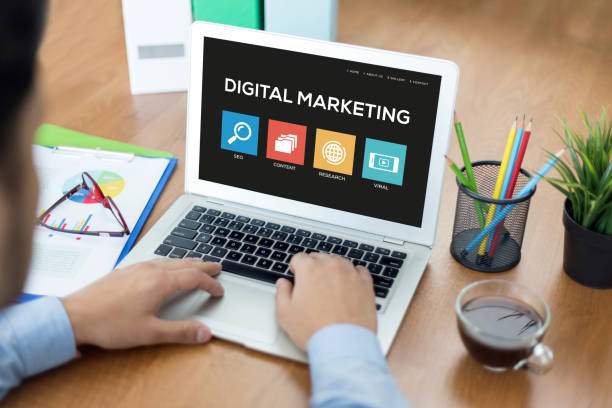
In the fast paced digital landscape, where connectivity is ubiquitous and consumer behavior evolves rapidly, digital marketing stands as a cornerstone for businesses aiming to thrive and grow. This comprehensive guide explores the key components, strategies, and best practices that define effective digital marketing campaigns in today’s competitive environment.
- Understanding Digital Marketing
Digital marketing encompasses all online efforts aimed at connecting with potential customers through digital channels. It leverages the internet and digital technologies to reach and engage audiences across various platforms. Key components of digital marketing include:
Website Optimization: Your website serves as the hub of your digital presence. Ensure it is user friendly, mobile responsive, and optimized for search engines (SEO) to attract organic traffic.
Content Marketing: Creating valuable, relevant, and consistent content (blogs, articles, videos, infographics) establishes your authority, attracts traffic, and nurtures leads through the sales funnel.
Social Media Marketing: Utilizing social media platforms (Facebook, Instagram, Twitter, LinkedIn, etc.) to build brand awareness, engage with your audience, and drive website traffic.
Email Marketing: Targeted email campaigns help nurture leads, retain customers, and drive conversions through personalized communication and automation.
Search Engine Marketing (SEM): Paid advertising on search engines (Google Ads) and other platforms (Bing Ads, Yahoo Ads) to appear in search results and drive immediate traffic.
Novabizmagnet | rfindy | urbangrowths | fibrecco | truedigiweb
Analytics and Data Insights: Using tools like Google Analytics to measure performance, track KPIs (Key Performance Indicators), and optimize strategies based on data driven insights.
- Crafting Your Digital Marketing Strategy
A successful digital marketing strategy begins with a clear understanding of your business goals, target audience, and competitive landscape. Follow these steps to craft an effective strategy:
Define Objectives: Establish specific, measurable goals such as increasing website traffic, generating leads, improving brand visibility, or boosting sales conversions.
Know Your Audience: Create detailed buyer personas based on demographic data, interests, behaviors, and pain points to tailor your messaging and targeting.
Choose the Right Channels: Select digital channels that align with your audience preferences and business objectives. Balance between organic (SEO, content marketing) and paid (SEM, social ads) strategies.
Content Planning: Develop a content calendar outlining topics, formats, and distribution channels to ensure consistent and relevant communication with your audience.
Budget Allocation: Allocate budget resources effectively across different channels based on ROI projections and campaign objectives.
- Implementing Effective Digital Marketing Tactics
Effective execution of digital marketing tactics requires a blend of creativity, technical expertise, and strategic planning. Here are key tactics to consider:
Search Engine Optimization (SEO): Optimize your website and content to rank higher in organic search results. Focus on keywords, quality backlinks, and user experience (UX).
Content Marketing: Create valuable and shareable content that resonates with your audience’s needs and interests. Utilize SEO best practices to drive organic traffic.
Social Media Engagement: Engage with your audience through regular posts, stories, live videos, and community interactions. Utilize paid ads to amplify reach and target specific demographics.
Email Campaigns: Segment your email list based on customer behavior and preferences. Personalize content to nurture leads, promote products/services, and encourage repeat purchases.
Pay Per Click (PPC) Advertising: Set up targeted campaigns on platforms like Google Ads or social media channels to drive immediate traffic, conversions, and ROI.
Influencer Partnerships: Collaborate with influencers or industry experts to leverage their credibility and reach among your target audience.
- Measuring and Analyzing Performance
Continuous monitoring and analysis of digital marketing efforts are essential to optimize performance and achieve sustainable growth. Use metrics and tools to track KPIs and make data driven decisions:
Key Metrics: Monitor metrics such as website traffic, conversion rates, clickthrough rates (CTR), cost per acquisition (CPA), and return on investment (ROI).
Google Analytics: Utilize Google Analytics to gain insights into user behavior, traffic sources, demographics, and content performance. Set up goals and conversions to track campaign effectiveness.
A/B Testing: Experiment with different elements (headlines, images, CTAs) in your campaigns to identify what resonates best with your audience and improves performance.
Reporting: Regularly analyze performance reports to identify trends, strengths, weaknesses, and opportunities for optimization. Adjust strategies accordingly to maximize results.
- Adapting to Trends and Innovations
Digital marketing is constantly evolving with technological advancements, consumer behavior shifts, and platform updates. Stay ahead of the curve by embracing emerging trends and innovations:
Voice Search Optimization: Optimize content for voice search queries as smart speakers and voice assistants gain popularity.
Video Marketing: Incorporate video content into your strategy (live streaming, tutorials, product demos) to engage audiences and increase conversion rates.
AI and Automation: Utilize AI powered tools for personalization, predictive analytics, chatbots, and automated campaign management.
Augmented Reality (AR) and Virtual Reality (VR): Explore interactive and immersive experiences to enhance customer engagement and drive brand loyalty.
- Conclusion
In conclusion, digital marketing offers businesses unparalleled opportunities to connect with audiences, drive engagement, and achieve measurable results. By leveraging the diverse array of digital channels, implementing strategic tactics, and continuously optimizing performance based on analytics, businesses can navigate the complexities of the digital landscape and emerge successful. Embrace innovation, stay adaptable, and prioritize customer centric strategies to thrive in the dynamic world of digital marketing. Remember, mastering digital marketing is not just about reaching more customers—it’s about building lasting relationships and driving sustainable growth in the digital age.

